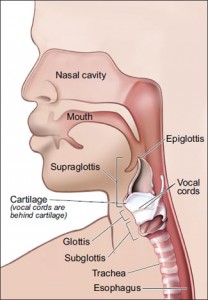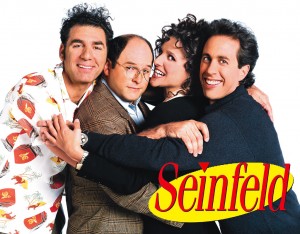Jerry Seinfeld appears in this frustrating New York Times video teasingly entitled “How to Write a Joke.” In the video he calls comedy writing “a secretive thing.” He also says about his handwritten draft of a bit revolving around Pop Tarts, “I’ve never shown anybody this stuff.” Jerry then proves how secretive he is by hinting at, but never actually spelling out, some key techniques for writing jokes.
As one example, at 2:23 Jerry tells a joke that ends with the line “and we were like chimps in the dirt playing with sticks.” He explains, “What makes that joke is you got ‘chimps,’ ‘dirt,’ ‘playing,’ and ‘sticks.’ Seven words; four of them are funny.” But he never tells you what makes those words funny. So I will. There are two reasons:
1) Shorter words are funnier than longer words. One of Jerry’s four funny words has only two syllables. The other three words have only one. The four words are short.
 2) Words with stop (or “hard”) consonants are funnier than words without them. The stop consonants, in which the flow of air through the vocal cords stops completely, include B, D, G, K, P, and T. Jerry’s four short words contain a high concentration of stop consonants: six. Why are stop consonants funnier? My theory is that the sudden change in air flow they cause is a little surprise, and surprise is one of the keys to generating laughter.
2) Words with stop (or “hard”) consonants are funnier than words without them. The stop consonants, in which the flow of air through the vocal cords stops completely, include B, D, G, K, P, and T. Jerry’s four short words contain a high concentration of stop consonants: six. Why are stop consonants funnier? My theory is that the sudden change in air flow they cause is a little surprise, and surprise is one of the keys to generating laughter.
Those two comedy principles also explain why the words “Pop Tart” themselves are funny. Each of those two words is short–one syllable. And each word has two stop consonants. At :56 Jerry says, “It’s a fun thing to say…Pop Tart.” And now you know why that is.
Why didn’t Jerry explain those comedy principles to us? Maybe he thought that viewers of a New York Times video, even one entitled, “How to Write a Joke,” wouldn’t be interested in the nuts and bolts of how to write a joke.
 Or maybe Jerry thinks that comedy writing really should be a secretive thing. In the documentary film Dying Laughing, Jerry says that comedy is “beyond art–it’s magic.”
Or maybe Jerry thinks that comedy writing really should be a secretive thing. In the documentary film Dying Laughing, Jerry says that comedy is “beyond art–it’s magic.”
So maybe he feels that if he reveals the techniques that he uses he’ll be like a magician who reveals how he works his illusions and he’ll lose the admiration of the audience.
But Jerry, with his stand-up comedy and his brilliant show Seinfeld, has already more than earned our admiration.
Whatever Jerry’s reasoning, people who want to learn how to write a joke will not find that video illuminating. For more techniques that Jerry doesn’t want you to know, buy my book Comedy Writing for Late Night TV.
In his new Netflix special, “Jerry Seinfeld: 23 Hours To Kill,” Jerry reprises his Pop Tarts bit and adds one about texting in which he says this:
We like that word, don’t we? “Text!” It’s fun to say. It’s got that short, tight, got the X in there, a little bite to it. “Text it! Text!”
In saying that, Jerry comes a little closer to sharing the comedy principles that words are funnier if they are shorter and contain stop consonants.
As Jerry points out, “text” is short–only one syllable. And “text” contains a K sound, along with another stop consonant, T, which occurs twice, the same way it does in “Tart.”
Three stop consonant sounds in only one syllable–that’s why “text” is “fun to say,” and funnier in a joke than, for example, “email.”
 Postscript added May 12, 2020
Postscript added May 12, 2020
I love this bit of Jerry’s and think of it often. Funny thing, almost nobody gets it when I quote it, even after I explain it. Darren LaCroix has a great similar example where he tells a story about riding a motorcycle with a “macaroni strainer” on his head instead of a helmet. He added that if you used the normal word for that device (“colander”), the line wouldn’t be nearly as funny.
Yes, most people don’t understand how important wordsmithing is in comedy.
“Macaroni strainer” and “colander” each have two stop consonants, but I agree that “macaroni strainer” is funnier. I’d explain that by pointing to two of my Joke Maximizers:
Joke Maximizer #4 is “Make everything clear,” and I think that many people in the audience won’t immediately understand what a colander is in the context of that joke.
Joke Maximizer #9 is “Get specific,” and “macaroni strainer” is a specific way to use a colander.
Thanks for the follow-up, Joe. I really like those joke maximizers. I think you’re right, but in addition, macaroni may have funnier connotations in itself just as a word. I was thinking about this whole subject (and, if fact, found your blog because of it) because I just heard for the first time what I think must be one of the greatest movie lines of all time, from Woody Allen:
> The penguin skates on the stage dressed as a rabbi.
My first thought was: ten words, and five of them are funny – a lower ratio, but higher overall count, than Seinfeld’s. And it’s got the stops. But then I thought about it, and it’s more than just sounds and word length in all of these lines. Chimps are funny (or at least fun), just by themselves: it makes us smile to think about them. Penguins are funny – their little tuxes, the way they waddle, possibly connecting with a half-forgotten joke about nuns. And of course “A priest and a rabbi walk into a bar…”
Now that I’m here, I’ll definitely be reading your stuff! Thanks!
I agree. The Joke Maximizers can make a joke that’s already funny funnier.
But the unedited joke–like one that conjures up the image of a skating penguin/rabbi–still has to be funny.
Awesome story